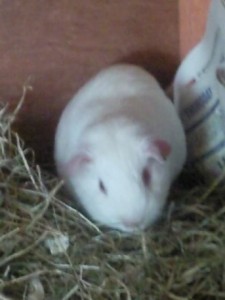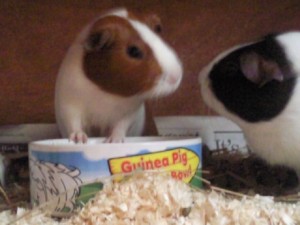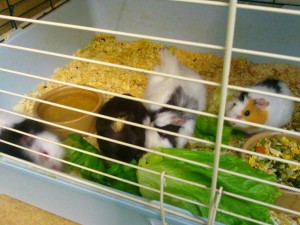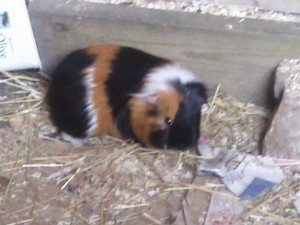Guinea Pig Bedding
 If you are thinking of getting a guinea pig as a pet you’ll need to know what type of bedding your new pet will need.
If you are thinking of getting a guinea pig as a pet you’ll need to know what type of bedding your new pet will need.
Firstly though, you’ll need to decide on your guinea pig’s home: a hutch or a cage. To see more about hutches and cages and which you should choose have a look at these posts: Choosing Guinea Pig Hutches, Choosing Guinea Pig Cages and Are Cages Better Than Hutches.
Bedding for Hutches
As a hutch is likely to be in a cooler environment than a cage, more bedding will be needed to keep your pet warm.

Sawdust or soft wood shavings – This can be used as a base layer, about one to two inches thick. This will act as an absorbent for urine. Some people have found that their guinea pigs are allergic to this material – if this is the case don’t use it. Such allergies to wood shavings are often caused by urine reacting with chemicals that have been added to the shavings producing phenols which can result in skin complaints and other problems, such as respiratory complications – seek a vet’s opinion if you notice anything worrying.
I use sawdust as a base layer (with hay on top) for all my guinea pigs and have not as yet found any problem, but you should always check your guinea pigs are allergic before using a lot of it.
Hay – You should cover the base of the hutch (or apply on top of the sawdust/wood shavings) with a generous supply of hay. You should have a lot more in the sleeping compartment than in the main compartment, as guinea pigs (especially baby guinea pigs) like to burrow a lot. A lot of guinea pigs will eat some of their hay as it is a good source of fibre so extra should always be put out every day if the guinea pig hasn’t enough to eat and use as bedding. Thicker, courser hay can be added to the sleeping compartment in the winter to provide a more substantial bedding and help the guinea pigs keep warm.
Warning: Never use straw. It is quite sharp and rough and can stick in the guinea pig’s skin. Cavies have very sensitive skin and straw has been known to cause skin complaints.
Tip: Before you put any bedding down, line the hutch with newspaper – this will make it easier to clean out next time. Alternatively stick a pet-friendly lino down with non-toxic glue to the floor of the hutch – this will help preserve the wood and make it easier to sweep out soiled bedding. Newspaper can be used on top of this lino.
Bedding for Cages
Here you have two options:
 The first would be to use the bedding that you’d use in a hutch: sawdust, hay and newspaper/lino (see above for more details) – Never use straw as it can be sharp and guinea pigs have sensitive skin. This is probably the best type of bedding to use as hay is a natural material and the guinea pig can also eat some of it if he or she is hungry.
The first would be to use the bedding that you’d use in a hutch: sawdust, hay and newspaper/lino (see above for more details) – Never use straw as it can be sharp and guinea pigs have sensitive skin. This is probably the best type of bedding to use as hay is a natural material and the guinea pig can also eat some of it if he or she is hungry.
The second type of bedding sometimes used in cages is shredded paper, or newspaper. This isn’t the best type of bedding to use as it isn’t that substantial and won’t be that good at keeping your pet warm (although a cage should be inside the house anyway). Another problem with using shredded paper is that the guinea pig could get ink poisoning if they eat it, which could be fairly likely in some guinea pigs.
 Whichever type of bedding you choose to use for your guinea pig’s cage, you should have an area, ideally cornered off or inside a separate box, where there is a lot more bedding for the guinea pig to burrow down in at night – baby guinea pigs especially love to burrow. The cornered off area will also provide an area where your pet can get some privacy.
Whichever type of bedding you choose to use for your guinea pig’s cage, you should have an area, ideally cornered off or inside a separate box, where there is a lot more bedding for the guinea pig to burrow down in at night – baby guinea pigs especially love to burrow. The cornered off area will also provide an area where your pet can get some privacy.
Tip: Some owners choose to line the cage with newspaper or stick a animal-friendly-lino down (with non toxic glue) as this makes it easier to clean out the next time – obviously the newspaper would have tho be replaced every time.
Warning: Some guinea pigs are allergic to sawdust – if this is the case don’t use it. Don’t use any materials that have had harmful or non-pet-friendly chemicals added to them.
 October 29, 2010
·
October 29, 2010
·  Maddia (Admin) ·
Maddia (Admin) ·  One Comment
One Comment
 Tags: guinea pig bedding, guinea pig cages, guinea pig care, guinea pig hutchings, guinea pigs · Posted in: Guinea Pig Care, Guinea Pig Information
Tags: guinea pig bedding, guinea pig cages, guinea pig care, guinea pig hutchings, guinea pigs · Posted in: Guinea Pig Care, Guinea Pig Information



One Response
This is such a great resource that you are providing and you give it away for free. I enjoy seeing websites that understand the value of providing a prime resource for free. I truly loved reading your post. Thanks!